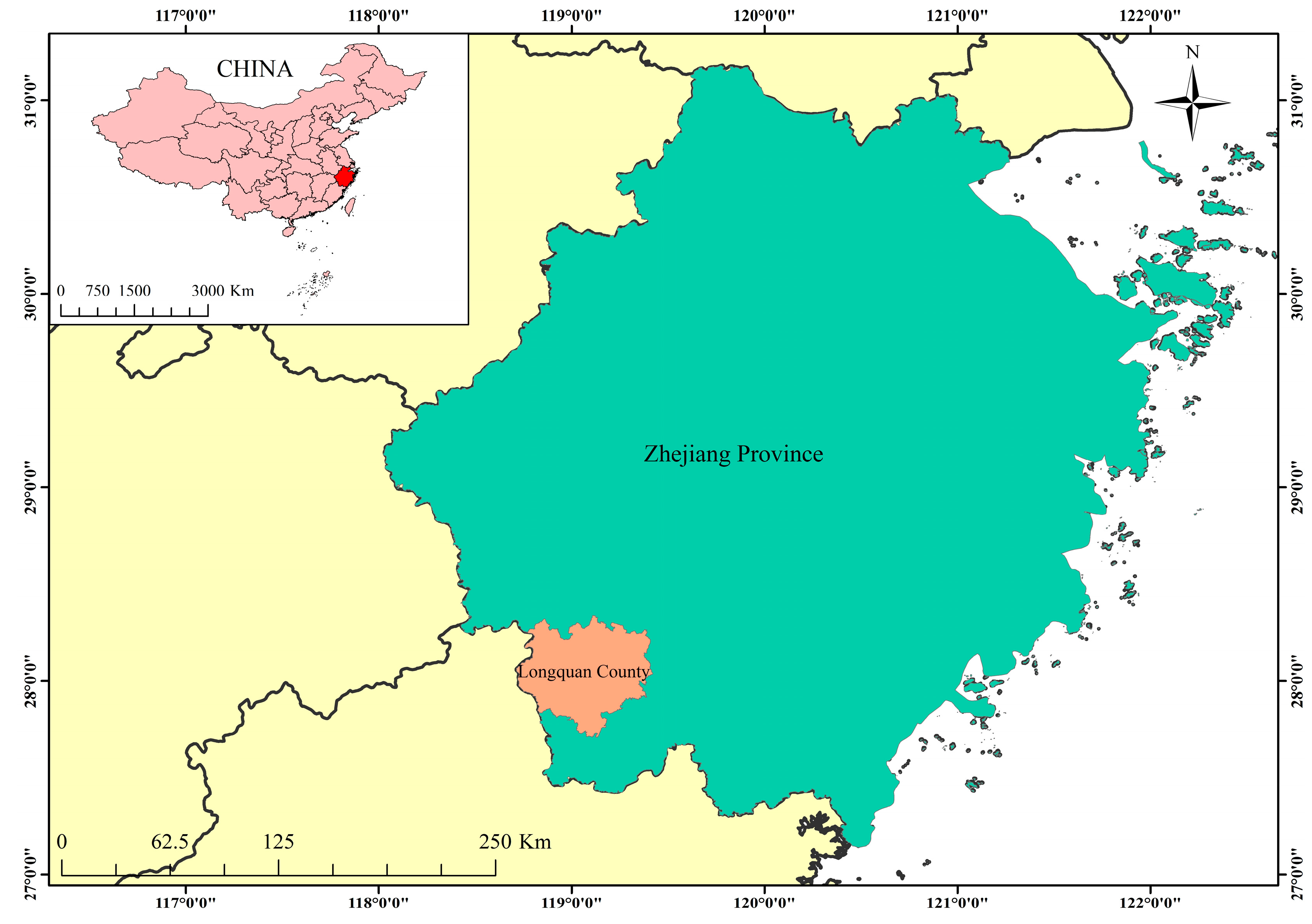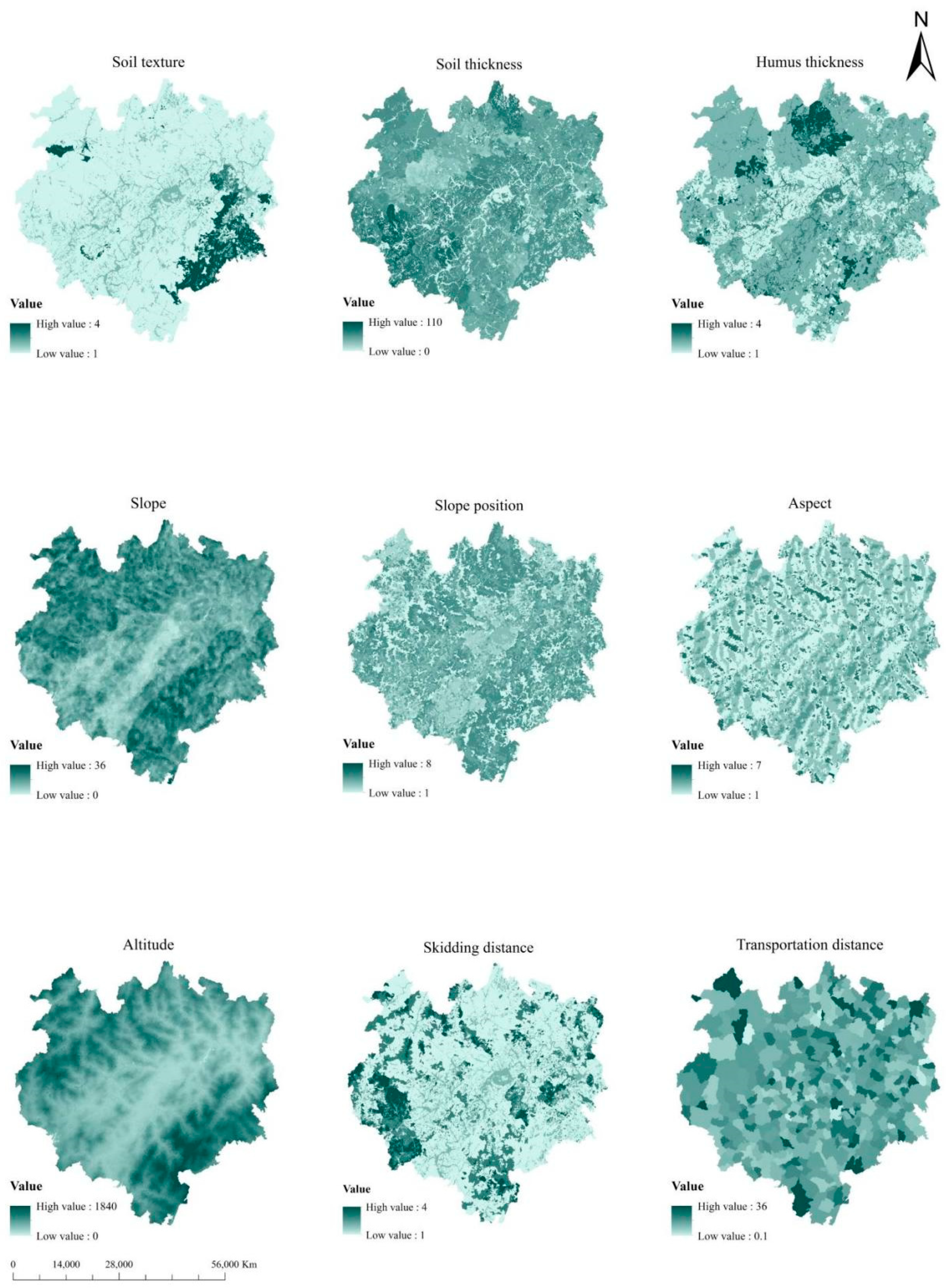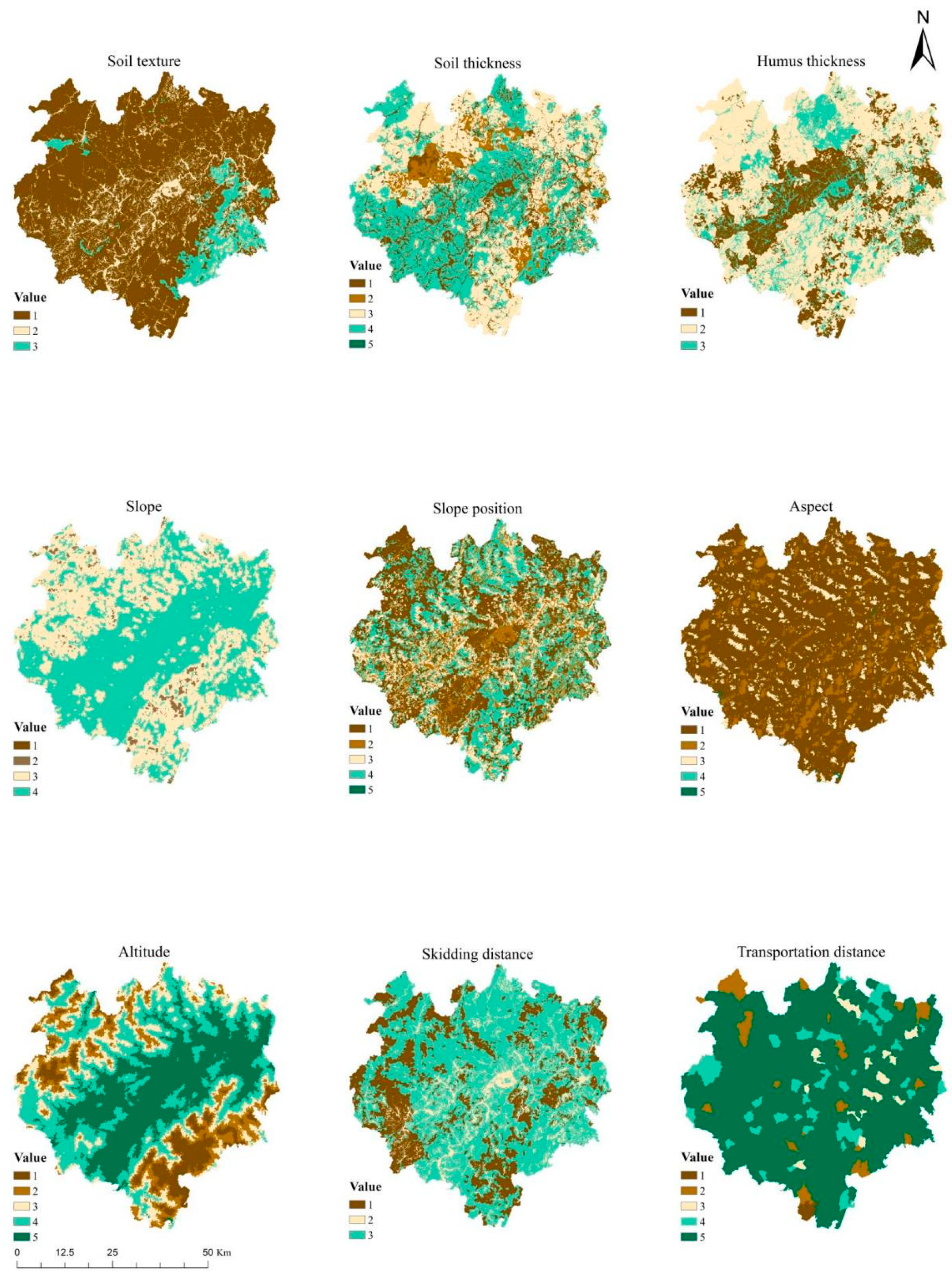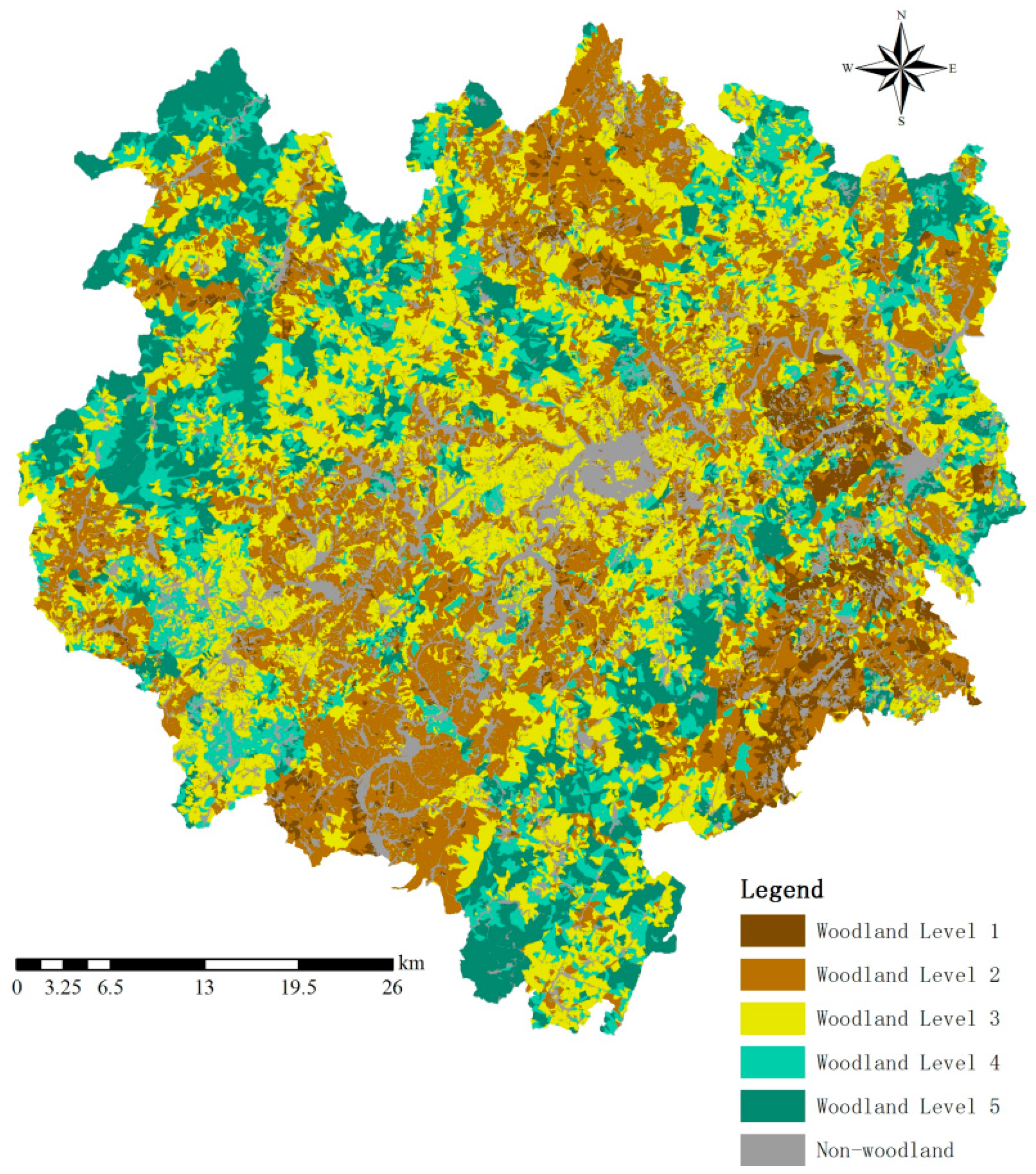Grade Division and Benchmark Price of Forestlands Using Geospatial Technology: A Case Study of Southeastern China
Abstract
:1. Introduction
2. Materials and Methods
2.1. Research Area
2.2. Data Collection and Processing
2.3. Research Methods
2.3.1. Forestland Grading Method
- (1)
- Determine the grading unit
- (2)
- Determination of grading index and weight value
- (3)
- Forestland Classification
2.3.2. The Benchmark Price of Forestland
2.3.3. Compilation of the Correction Coefficient for Forestland Price
- (1)
- Correction coefficient of land use period
- (2)
- Period–day correction coefficient
- (3)
- Other correction coefficients
3. Results
3.1. Forestland Grading
3.1.1. Rasterization of the Indicators
3.1.2. Reclassification of the Indicators
3.1.3. The Forestland Grading Results
3.2. The Benchmark Price of Forestland
3.3. Application of the Forestland Benchmark Price
4. Discussion
4.1. Establishment of Forest Land Grading Index System
4.2. Forestland Grading Method
4.3. Benchmark Price of Forestland
5. Conclusions
Author Contributions
Funding
Institutional Review Board Statement
Informed Consent Statement
Data Availability Statement
Acknowledgments
Conflicts of Interest
References
- Dudley, N.; Schlaepfer, R.; Jackson, W.; Jeanrenaud, J.P.; Stolton, S. Forest Quality: Assessing Forests at a Landscape Scale; Routledge: London, UK, 2012. [Google Scholar] [CrossRef]
- Stave, J.; Oba, G.; Charlotte, S.B.; Mengistu, Z.; Stenseth, N.C. Spatial and temporal woodland patterns along the lower Turkwel River, Kenya. Afr. J. Ecol. 2003, 41, 224–236. [Google Scholar] [CrossRef]
- Zaher, H.; Sabir, M.; Benjelloun, H.; Paul-Igor, H. Effect of forest land use change on carbohydrates, physical soil quality and carbon stocks in Moroccan cedar area. J. Environ. Manag. 2020, 254, 109544. [Google Scholar] [CrossRef] [PubMed]
- Karkuff, S.A. Quantifying Forest Subsidies to Food Webs in Woodland Pools. Master’s Thesis, State University of New York, Syracuse, NY, USA, 2014. [Google Scholar]
- Wong, M.H.; Chan, Y.S.G.; Zhang, C.; Ng, W.W. Comparison of pioneer and native woodland species growing on top of an engineered landfill, Hong Kong: Restoration programme. Land Degrad. Dev. 2016, 27, 500–510. [Google Scholar] [CrossRef]
- Chmura, D.J.; Anderson, P.D.; Howe, G.T.; Harrington, C.A.; Halofsky, J.E.; Peterson, D.L.; Shaw, D.C.; Clair, J.B.S. Forest responses to climate change in the northwestern United States: Ecophysiological foundations for adaptive management. For. Ecol. Manag. 2011, 261, 1121–1142. [Google Scholar] [CrossRef]
- Bowman, D.M.J.S.; Murphy, B.P.; Boer, M.M.; Bradstock, R.A.; Cary, G.J. Forest fire management, climate change, and the risk of catastrophic carbon losses. Front. Ecol. Environ. 2013, 11, 66–68. [Google Scholar] [CrossRef] [Green Version]
- Shi, J.H.; Jiang, A.J. Discussions about identifying forestland in plain areas. For. Resour. Manag. 2015, 1, 23–26. [Google Scholar] [CrossRef]
- State Forestry and Grassland Administration. China Forest Resources Report (2014–2018); China Forestry Press: Beijing, China, 2019. [Google Scholar]
- Köhl, M.; Lasco, R.; Cifuentes, M.; Jonsson, Ö.; Korhnen, K.T.; Mundhenk, P.; de Jesus Navar, J.; Stinson, G. Changes in forest production, biomass and carbon: Results from the 2015 UN FAO Global Forest Resource Assessment. For. Ecol. Manag. 2015, 352, 21–34. [Google Scholar] [CrossRef] [Green Version]
- Wisdom Research Consulting. China Forest Fire Protection Industry Current Research and Future Development T rend Analysis Report (2020–2026); China Market Research Network: Beijing, China, 2020. [Google Scholar]
- Bedia, J.; Camia, A.; Moreno, J.M.; Gutierrez Herrera, S. Forest fire danger projections in the Mediterranean using ENSEMBLES regional climate change scenarios. Clim. Chang. 2014, 122, 185–199. [Google Scholar] [CrossRef] [Green Version]
- Jian, S.; Joshua, S.F.; Jason, A.; Lynch, K.H.; Yang, G. Climate-driven Exceedance of Total (Wet + dry) Nitrogen (N) + sulfur (S) deposition to forest soil over the conterminous U.S. Earth’s Future 2017, 5, 560–576. [Google Scholar] [CrossRef] [Green Version]
- Barbier, E.B.; Burgess, J.C.; Grainger, A. The forest transition: Towards a more comprehensive theoretical framework. Land Use Policy 2010, 27, 98–107. [Google Scholar] [CrossRef]
- Chen, L.X.; Shi, G.X. Study on improving the quality of forest land of larch plantations. J. Northeast For. Univ. 1998, 26, 6–11. [Google Scholar]
- Chung, I.K. Quantitative forest land productivity survey and the result: Forest land capability classification in South Korea. Jpn. J. For. Environ. 1978, 19, 31–35. [Google Scholar]
- Martens, D.A.; Reedy, T.E.; Lewis, D.T. Soil organic carbon content and composition of 130-year crop, pasture and forest land-use managements. Glob. J. Chang. Biol. 2004, 10, 65–78. [Google Scholar] [CrossRef] [Green Version]
- Tan, J. Ways and Measures for Improving the Forest Land Productivity in Dongxing County; FAO: Rome, Italy, 2013. [Google Scholar]
- Layser, E.F. Preliminary Classification for the Coniferous Forest and Woodland Series of Arizona and New Mexico; Rocky Mountain Forest and Range Experiment Station, Forest Service, US Department of Agriculture; Utah State University: Logan, UT, USA, 1979. [Google Scholar]
- Corrigan, M.M. Study of the Properties, Classification, and Woodland Site Quality for High Elevation Soils in Western Virginia. Master’s Thesis, Virginia Tech, Blacksburg, VA, USA, 1995. [Google Scholar]
- Chen, C.; Tang, P.; Wu, H. Improving classification of woodland types using modified prior probabilities and Gaussian mixed model in mountainous landscapes. Int. J. Remote. Sens. 2013, 34, 8518–8533. [Google Scholar] [CrossRef]
- Sonti, S.H. Application of geographic information system (GIS) in forest management. J. Geogr. Nat. Disasters 2015, 5, 1000145. [Google Scholar] [CrossRef] [Green Version]
- Koch, N.E.; Hirokazu, Y.; Kahle, H.-P.; Hasenauer, H.; Centritto, M.; Kjell, N.; Peng, Z.; Weimin, S.; Fuliang, C.; Shirong, L.; et al. Classification of Integrated Quality of Chinese Woodland Using Fuzzy Mathemtics. In Proceedings of the International Conference on Sustainable Forest Management—Forest Science Forum, Beijing, China, 19 October 2012; pp. 13–16. [Google Scholar]
- Goushegir, S.Z.; Feghhi, J.; Mohajer, M.R.M.; Makhdoum, M. Criteria and Indicators of monitoring the sustainable wood production and forest conservation using AHP (Case study: Kheyrud educational and research forest). Afr. J. Agric. Res. 2009, 4, 1041–1048. [Google Scholar] [CrossRef]
- Chen, Z.; Yang, C.; Deng, D.; Zhihua, L.I. Analysis of influencing factors and model prediction of forest coverage in Guangdong Province: Based on grey correlation analysis and GM (1,1) model. Environ. Sci. 2017, 33, 101–106. [Google Scholar] [CrossRef]
- Valjarević, A.; Djekić, T.; Stevanović, V.; Ivanović, R.; Jandziković, B. GIS numerical and remote sensing analyses of forest changes in the Toplica region for the period of 1953–2013. Appl. Geogr. 2018, 92, 131–139. [Google Scholar] [CrossRef]
- Anil, P.; Nidhi, R.; Nirmal, K.S. Assessment of forest land degradation by remote sensing and gis: A case study of jaisamand wildlife sanctuary, udaipur (rajasthan). Ecol. Environ. Conserv. 2021, 27, 447–454. [Google Scholar]
- Ismail, M.A.; Ludin, A.; Hosni, N. Comparative Assessment of the Unsupervised Land Use Classification by Using Proprietary GIS and Open Source Software. IOP Conf. Ser. Earth Environ. Sci. 2020, 540, 012020. [Google Scholar] [CrossRef]
- Pokhariya, H.S.; Singh, D.P.; Prakash, R. Investigating the impacts of urbanization on different land cover classes and land surface temperature using GIS and RS techniques. Int. J. Syst. Assur. Eng. Manag. 2021, 29, 1–9. [Google Scholar] [CrossRef]
- Masayi, N.N.; Omondi, P.; Tsingalia, M. Assessment of land use and land cover changes in Kenya’s Mt. Elgon forest ecosystem. Afr. J. Ecol. 2021, 59, 988–1003. [Google Scholar] [CrossRef]
- Healy, M.J.; Bergquist, K. The sales comparison approach and timberland valuation. Apprais. J. 1994, 62, 587–595. [Google Scholar]
- You, S.M.; Chang, C.O. Weight regression model from the sales comparison approach. Prop. Manag. 2009, 27, 302–318. [Google Scholar] [CrossRef]
- Kalle, E.; Mika, V. Deriving market prices for forestland properties from comparables. Prop. Manag. 2018, 36, 423–445. [Google Scholar] [CrossRef]
- da Silva, M.L.; Rocha, R.R.d.; Cordeiro, S.A.; da Silva, M.L.M.; Bezerra, A.F. Comparative study of three forestland assessment methods. Cerne 2011, 17, 209–213. [Google Scholar]
- Kennedy, G.A.; Vandeveer, L.R.; Henning, S.A.; Niu, H.; Deckard, D.L. Estimating Tract value relationships in the North Louisiana timberland market. Southwest. Econ. Rev. 2011, 29, 123–134. [Google Scholar]
- Zhang, D.; Meng, L.; Polyakov, M. Determinants of the Prices of Bare Forestland and Premerchantable Timber Stands: A Spatial Hedonic Study. For. Sci. 2013, 59, 400–406. [Google Scholar] [CrossRef] [Green Version]
- Xie, Z.G.; Han, G.K.; Tong, H.W.; Xu, J.; Ge, W.N.; He, B.T. Serial forest price and its application in the assessment of forest resources assets. For. Sci. 2016, 52, 43–53. (In Chinese) [Google Scholar]
- Liu, H.; Zheng, M.; Liu, J.; Zheng, X. Sustainable land use in the trans-provincial marginal areas in China. Resour. Conserv. Recycl. 2020, 157, 104783. [Google Scholar] [CrossRef]
- Wang, L.; Zhou, Y.; Li, Q.; Zuo, Q.; Gao, H.; Liu, J.; Tian, Y. Forest Land Quality Evaluation and the Protection Zoning of Subtropical Humid Evergreen Broadleaf Forest Region Based on the PSO-TOPSIS Model and the Local Indicator of Spatial Association: A Case Study of Hefeng County, Hubei Province, China. Forests 2021, 12, 325. [Google Scholar] [CrossRef]
- Wu, J.; Lin, W.; Peng, X.; Liu, W. A Review of Forest Resources and Forest Biodiversity Evaluation System in China. Int. J. For. Res. 2013, 2013, 1–7. [Google Scholar] [CrossRef] [Green Version]
- Gu, L.; Gong, Z.W.; Bu, Y.K. Forest Quality Dynamic Change and Its Driving Factors Accompanied by Forest Transition in China. Forests 2021, 12, 733. [Google Scholar] [CrossRef]
- Zhang, Z.Y.; Liu, P.J.; Tang, X.M. Evaluation of forest land quality based on rough set and C5.0 decision tree. J. Northwest A F Univ. Nat. Sci. Ed. 2017, 45, 96–102. [Google Scholar]
- Pokharel, B.; Dech, J.P. An ecological land classification approach to modeling the production of forest biomass. For. Chron. 2011, 87, 23–32. [Google Scholar] [CrossRef]
- Tang, X.; Huang, Q.; Lefsky, M.A.; Huang, L.; Wu, W. Dividing the topographical advantage of forestland by spatial analysis and the analytic hierarchy process. J. Sustain. For. 2021, 40, 263–280. [Google Scholar] [CrossRef]
- 45. Fields-Johnson, C.W.; Zipper, C.E.; Burger, J.A.; Evans, D.M. Forest restoration on steep slopes after coal surface mining in Appalachian USA: Soil grading and seeding effects. For. Ecol. Manag. 2012, 270, 126–134. [Google Scholar] [CrossRef]
- Yang, Z.G. Research on the Evaluation of Forest Benchmark Land Price. Ph.D. Thesis, Fujian Agriculture and Forestry University, Fuzhou, China, 2008. (In Chinese). [Google Scholar]
- Xu, C.; Cheng, B.; Li, L.; Xu, X. Does political identity lower circulating rent: An empirical test from Zhejiang Province. J. Agric. Technol. Econ. 2019, 9, 73–81. (In Chinese) [Google Scholar]
- Zhang, H.R.; Lei, X.D.; Li, F.R. Research progress and prospects of forest management science in China. Sci. Silv. Sin. 2020, 56, 130–142. [Google Scholar]
- Wang, H.B. The Study and Practice of Forestland Modern Management Mode and the Key Issues in China. Ph.D. Thesis, Beijing Forestry University, Beijing, China, 2011. (In Chinese). [Google Scholar]
- Mo, K. The Study on Quality Assessment Indicator System of Timber Forest and Its Methods at Subcompartment Level. Ph.D. Thesis, Beijing Forestry University, Beijing, China, 2012. (In Chinese). [Google Scholar]
- Deng, W.Q. Evaluation of Qaulity of Woodland of Changsha County. Master’s Thesis, Central South University of Forestry and Technology, Changsha, China, 2013. (In Chinese). [Google Scholar]
- Liu, L.M.; Zhou, D.; Chang, X.; Lin, Z.L. A new grading system for evaluating China’s cultivated land quality. Land Degrad. Dev. 2020, 31, 1482–1501. [Google Scholar] [CrossRef]
- Scaloppi, E.J.; Willardson, L.S. Practical Land Grading Based on Least Squares. J. Irrig. Drain. Eng. 1986, 112, 98–109. [Google Scholar] [CrossRef] [Green Version]
- Xia, W. Forest land classification and grading and research of the model. Netw. Secur. Technol. Appl. 2014, 11, 183–184, 186. [Google Scholar]
- Pippuri, I.; Suvanto, A.; Maltamo, M.; Korhonen, K.T.; Pitkänen, J.; Packalen, P. Classification of forest land attributes using multi-source remotely sensed data. Int. J. Appl. Earth Obs. Geoinf. 2016, 44, 11–22. [Google Scholar] [CrossRef]
- Ford, M.M.; Zamora, D.S.; Current, D.; Magner, J.; Wyatt, G.; Walter, W.D.; Vaughan, S. Impact of managed woodland grazing on forage quantity, quality and livestock performance: The potential for silvopasture in Central Minnesota, USA. Agrofor. Syst. 2019, 93, 67–79. [Google Scholar] [CrossRef]
- Tian, Y.; Fan, P.; Yang, Q.; Yang, X.; Wang, L. Theoretical Study on the Regional Comprehensive Price of Expropriated Agricultural Land Based on the Benchmark Land Price. Asian Agric. Res. 2021, 13, 20–23. [Google Scholar] [CrossRef]
- Tian, Y.; Song, L.; Wang, L.; Yang, X.; Yang, Q. Research on the Balance of Urban Benchmark Land Price in Henan Province: A Case Study of Commercial Land. Asian Agric. Res. 2021, 13, 28–53. [Google Scholar] [CrossRef]
- Weibing, Z. Construction and Application of Urban Benchmark Land Price Evaluation Model—Take Commercial Land in Downtown of Longkou as a Case. Mod. Manag. 2020, 10, 909–917. [Google Scholar] [CrossRef]
- Remme, R.P. Spatial accounting for ecosystem services in Limburg, the Netherlands. Berlin Germany, 2014. [Google Scholar]
- Lamichhane, R.; Sedhain, A.; Maharjan, M. Economic value of community forest to local users: A case study from Barandabhar Protected Forest, Chitwan, Nepal. Banko Janakari 2019, 29, 20–27. [Google Scholar] [CrossRef]
- Deng, S.; Xia, Y. Research on green plant development and forest asset accounting based on GIS system data. Arab. J. Geosci. 2021, 14, 1–5. [Google Scholar] [CrossRef]
- Campos, P.; Álvarez, A.; Oviedo, J.L.; Ovando, P.; Mesa, B.; Caparrós, A. Refined Systems of National Accounts and Experimental Ecosystem Accounting Versus the Simplified Agroforestry Accounting System: Testing in Andalusian Holm Oak Open Woodlands. Forests 2020, 11, 393. [Google Scholar] [CrossRef] [Green Version]
- Campbell, E.T.; Tilley, D.R. Valuing ecosystem services from Maryland forests using environmental accounting. Ecosyst. Serv. 2014, 7, 141–151. [Google Scholar] [CrossRef]
- Loomis, J.J.; Knaus, M.; Dziedzic, M. Integrated quantification of forest total economic value. Land Use Policy 2019, 84, 335–346. [Google Scholar] [CrossRef]
- Sukarna, R.M.; Yulianto, S.; Reri, Y. Economic Value of Secondary Natural Forest Resources in District of East Kotawaringin Central Kalimantan Province. Agr. Ecosyst. Eviron. 2019, 12, 1–19. [Google Scholar]




| First Level Indicator | Secondary Indicators | Positive and Negative Indicators | Weights |
|---|---|---|---|
| Natural factors | Soil texture | − | 0.15 |
| Soil thickness | + | 0.15 | |
| Humus thickness | + | 0.15 | |
| Slope | − | 0.1 | |
| Aspect | + | 0.05 | |
| Slope position | + | 0.05 | |
| Altitude | − | 0.05 | |
| Location factor | Transportation distance | − | 0.15 |
| Skidding distance | − | 0.15 |
| Index | Index Characteristics | Level | Role Assignment |
|---|---|---|---|
| Soil texture | Loam | 1 | 8.75 |
| Clay | 2 | 5.5 | |
| Sand | 3 | 2.75 | |
| Skidding distance/km | Grade I (≤2) | 1 | 8.75 |
| Grade II (2 < S ≤ 4) | 2 | 5.5 | |
| Grade II (4 < S ≤ 6) | 3 | 2.75 | |
| Soil thickness/cm | >100 | 1 | 9 |
| 51~100 | 2 | 7 | |
| 31~50 | 3 | 5 | |
| 16~30 | 4 | 3 | |
| ≤15 | 5 | 1 | |
| Humus thickness/cm | >20 | 1 | 9 |
| 15~20 | 2 | 7 | |
| 10~15 | 3 | 5 | |
| 5~10 | 4 | 3 | |
| ≤5 | 5 | 1 | |
| Altitude/m | H ≤ 500 | 1 | 9 |
| 500 < H ≤ 800 | 2 | 7 | |
| 800 < H ≤ 1000 | 3 | 5 | |
| 1000 < H ≤ 1200 | 4 | 3 | |
| H > 1200 | 5 | 1 | |
| Transportation distance/m | ≤20 | 1 | 9 |
| 21~25 | 2 | 7 | |
| 26~30 | 3 | 5 | |
| 31~35 | 4 | 3 | |
| >35 | 5 | 1 | |
| Slope/° | Flat slope and gentle slope (≤15°) | 1 | 9 |
| Slope (15°~24°) | 2 | 7 | |
| Steep slope (25°~34°) | 3 | 5 | |
| Steep slope (35°~44°) | 4 | 3 | |
| Dangerous slope (≥45°) | 5 | 1 | |
| Aspect | No slope and north slope | 1 | 9 |
| East slope and Northeast slope | 2 | 7 | |
| Northwest slope and southeast slope | 3 | 5 | |
| West slope | 4 | 3 | |
| Southwest slope and south slope | 5 | 1 | |
| Slope position | Flat and all slope | 1 | 9 |
| Valley and downhill | 2 | 7 | |
| Middle slope | 3 | 5 | |
| Uphill | 4 | 3 | |
| Spine | 5 | 1 |
| Forestland Grade | Number of Small Classes | Proportion (%) | Area/ha | Proportion(%) |
|---|---|---|---|---|
| 1 | 3335 | 5.8 | 11,709 | 4.4 |
| 2 | 20,944 | 36.3 | 75,694 | 28.5 |
| 3 | 19,490 | 33.8 | 88,814 | 33.5 |
| 4 | 8134 | 14.1 | 43,996 | 16.6 |
| 5 | 5775 | 10.0 | 45,061 | 17.0 |
| Total | 57,678 | 100 | 265,273 | 100 |
| Forestland Grade | Average Score | Ratio to Standard Forest Land | Benchmark Price of Woodland/(CNY/ha) | Average Land Rent/(CNY/Year/ha) |
|---|---|---|---|---|
| 1 | 7.4 | 1.1 | 10,380 | 623 |
| 2 | 6.8 | 1.0 | 9493 | 570 |
| 3 | 6.2 | 0.9 | 8708 | 523 |
| 4 | 5.6 | 0.8 | 7827 | 470 |
| 5 | 4.8 | 0.7 | 6771 | 406 |
| Forestland Grade | Young Forest | Middle Aged Forest | Near Mature Forest | Mature Forest | Over Mature Forest | |||||
|---|---|---|---|---|---|---|---|---|---|---|
| Average Height (m) | Number of Plants (Plant/ha) | Average Height (m) | Accumulation (m3/ha) | Average Height (m) | Accumulation (m3/ha) | Average Height (m) | Accumulation (m3/ha) | Average Height (m) | Accumulation (m3/ha) | |
| 1 | 3.7 | 2372 | 7.2 | 4.9 | 9.2 | 8.4 | 10.0 | 9.8 | 10.9 | 12.4 |
| 2 | 3.5 | 2223 | 6.7 | 4.2 | 8.8 | 7.7 | 9.7 | 9.8 | 10.3 | 10.9 |
| 3 | 3.8 | 2233 | 7.0 | 4.4 | 8.7 | 7.6 | 9.9 | 9.5 | 10.2 | 9.9 |
| 4 | 3.4 | 2358 | 7.0 | 4.2 | 8.7 | 7.5 | 9.5 | 8.8 | 10.1 | 9.8 |
| 5 | 3.4 | 2268 | 7.0 | 4.0 | 8.3 | 6.2 | 9.4 | 8.1 | 9.9 | 8.6 |
| Forestland Grade | Area (ha) | Benchmark Price of Woodland (CNY/ha) | Economic Value of Forest Land Resource Assets (Million CNY) |
|---|---|---|---|
| 1 | 11,709 | 10,380 | 115 |
| 2 | 75,694 | 9493 | 708 |
| 3 | 88,814 | 8708 | 758 |
| 4 | 43,996 | 7827 | 330 |
| 5 | 45,061 | 6771 | 337 |
| Total | 265,273 | 2248 |
Publisher’s Note: MDPI stays neutral with regard to jurisdictional claims in published maps and institutional affiliations. |
© 2022 by the authors. Licensee MDPI, Basel, Switzerland. This article is an open access article distributed under the terms and conditions of the Creative Commons Attribution (CC BY) license (https://creativecommons.org/licenses/by/4.0/).
Share and Cite
Wu, L.; Zhang, W.; Li, M.; Chen, F. Grade Division and Benchmark Price of Forestlands Using Geospatial Technology: A Case Study of Southeastern China. Forests 2022, 13, 1105. https://doi.org/10.3390/f13071105
Wu L, Zhang W, Li M, Chen F. Grade Division and Benchmark Price of Forestlands Using Geospatial Technology: A Case Study of Southeastern China. Forests. 2022; 13(7):1105. https://doi.org/10.3390/f13071105
Chicago/Turabian StyleWu, Lianbei, Weimin Zhang, Mingyue Li, and Fangyuan Chen. 2022. "Grade Division and Benchmark Price of Forestlands Using Geospatial Technology: A Case Study of Southeastern China" Forests 13, no. 7: 1105. https://doi.org/10.3390/f13071105
APA StyleWu, L., Zhang, W., Li, M., & Chen, F. (2022). Grade Division and Benchmark Price of Forestlands Using Geospatial Technology: A Case Study of Southeastern China. Forests, 13(7), 1105. https://doi.org/10.3390/f13071105





